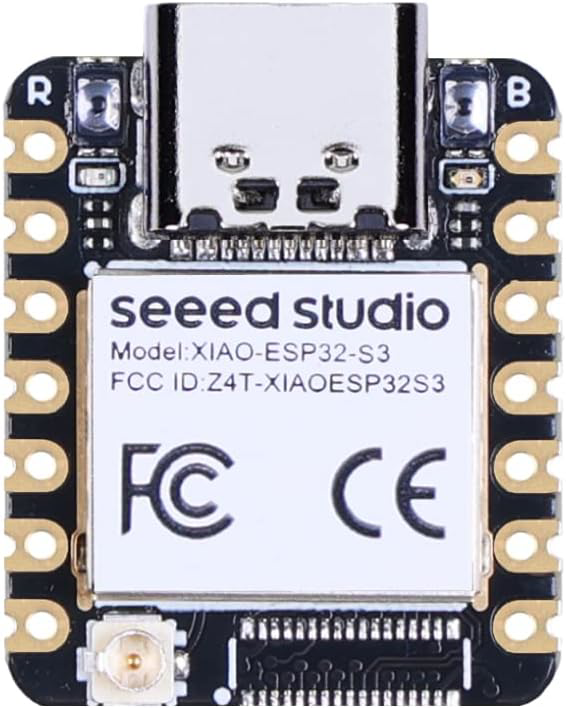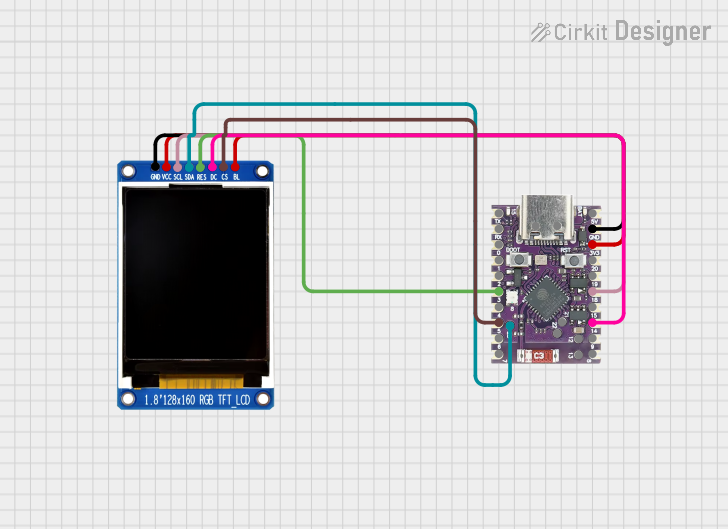
How to Use Seed Studio XIAO ESP32 S3: Examples, Pinouts, and Specs

 Design with Seed Studio XIAO ESP32 S3 in Cirkit Designer
Design with Seed Studio XIAO ESP32 S3 in Cirkit DesignerIntroduction
The Seeed Studio XIAO ESP32 S3 is a compact and powerful microcontroller board based on the ESP32-S3 chip. It is designed for IoT (Internet of Things) applications, offering built-in Wi-Fi and Bluetooth 5.0 capabilities. With its small form factor and robust processing power, the XIAO ESP32 S3 is ideal for projects requiring wireless connectivity, such as smart home devices, wearable electronics, and remote monitoring systems.
Explore Projects Built with Seed Studio XIAO ESP32 S3

 Open Project in Cirkit Designer
Open Project in Cirkit Designer
 Open Project in Cirkit Designer
Open Project in Cirkit Designer
 Open Project in Cirkit Designer
Open Project in Cirkit Designer
 Open Project in Cirkit Designer
Open Project in Cirkit DesignerExplore Projects Built with Seed Studio XIAO ESP32 S3

 Open Project in Cirkit Designer
Open Project in Cirkit Designer
 Open Project in Cirkit Designer
Open Project in Cirkit Designer
 Open Project in Cirkit Designer
Open Project in Cirkit Designer
 Open Project in Cirkit Designer
Open Project in Cirkit DesignerCommon Applications and Use Cases
- IoT devices and smart home automation
- Wearable electronics and portable gadgets
- Wireless data logging and remote sensing
- Robotics and automation systems
- Prototyping for AI and machine learning at the edge
Technical Specifications
The following table outlines the key technical details of the Seeed Studio XIAO ESP32 S3:
| Specification | Details |
|---|---|
| Microcontroller | ESP32-S3 (Xtensa® 32-bit LX7 dual-core processor) |
| Clock Speed | Up to 240 MHz |
| Flash Memory | 8 MB |
| SRAM | 512 KB |
| Wireless Connectivity | Wi-Fi 802.11 b/g/n (2.4 GHz), Bluetooth 5.0 (LE) |
| Operating Voltage | 3.3V |
| Input Voltage | 5V (via USB-C) |
| GPIO Pins | 11 (including ADC, DAC, I2C, SPI, UART, PWM) |
| USB Interface | USB-C (supports programming and power supply) |
| Power Consumption | Ultra-low power consumption in deep sleep mode |
| Dimensions | 21 x 17.5 mm |
| Weight | 3.5 g |
Pin Configuration and Descriptions
The XIAO ESP32 S3 features a total of 11 GPIO pins, which are multifunctional and can be configured for various purposes. Below is the pinout description:
| Pin | Name | Function |
|---|---|---|
| 1 | 3V3 | 3.3V power output |
| 2 | GND | Ground |
| 3 | D0 | GPIO0, ADC, UART TX, PWM |
| 4 | D1 | GPIO1, ADC, UART RX, PWM |
| 5 | D2 | GPIO2, ADC, I2C SDA, PWM |
| 6 | D3 | GPIO3, ADC, I2C SCL, PWM |
| 7 | D4 | GPIO4, SPI MOSI, PWM |
| 8 | D5 | GPIO5, SPI MISO, PWM |
| 9 | D6 | GPIO6, SPI SCK, PWM |
| 10 | D7 | GPIO7, DAC, PWM |
| 11 | D8 | GPIO8, DAC, PWM |
Usage Instructions
How to Use the Component in a Circuit
Powering the Board:
- Connect the XIAO ESP32 S3 to your computer or power source using a USB-C cable. The board operates at 3.3V internally but accepts 5V input via USB.
Programming the Board:
- The board can be programmed using the Arduino IDE or other ESP32-compatible development environments. Install the necessary ESP32 board support package in the Arduino IDE.
Connecting Peripherals:
- Use the GPIO pins to connect sensors, actuators, or other peripherals. Ensure that the voltage levels of connected devices are compatible with the 3.3V logic of the XIAO ESP32 S3.
Wireless Connectivity:
- Configure the built-in Wi-Fi and Bluetooth for wireless communication. Libraries such as
WiFi.handBluetoothSerial.hcan be used for this purpose.
- Configure the built-in Wi-Fi and Bluetooth for wireless communication. Libraries such as
Important Considerations and Best Practices
- Voltage Levels: Ensure that all connected peripherals operate at 3.3V logic levels to avoid damaging the board.
- Deep Sleep Mode: Utilize the deep sleep mode for ultra-low power consumption in battery-powered applications.
- Pin Multiplexing: Be aware that some pins have multiple functions (e.g., ADC, I2C, UART). Configure them appropriately in your code.
- Heat Management: While the board is efficient, prolonged high-performance operation may generate heat. Ensure proper ventilation if used in enclosed spaces.
Example Code for Arduino UNO
Below is an example of how to connect the XIAO ESP32 S3 to a Wi-Fi network and blink an LED:
#include <WiFi.h> // Include the Wi-Fi library
// Replace with your network credentials
const char* ssid = "Your_SSID";
const char* password = "Your_PASSWORD";
void setup() {
pinMode(2, OUTPUT); // Set GPIO2 (D0) as an output pin for the LED
Serial.begin(115200); // Start serial communication
Serial.println("Connecting to Wi-Fi...");
// Connect to Wi-Fi
WiFi.begin(ssid, password);
while (WiFi.status() != WL_CONNECTED) {
delay(1000);
Serial.println("Connecting...");
}
Serial.println("Connected to Wi-Fi!");
}
void loop() {
digitalWrite(2, HIGH); // Turn the LED on
delay(1000); // Wait for 1 second
digitalWrite(2, LOW); // Turn the LED off
delay(1000); // Wait for 1 second
}
Troubleshooting and FAQs
Common Issues and Solutions
The board is not detected by the computer:
- Ensure that the USB-C cable supports data transfer (not just charging).
- Check if the correct drivers for the ESP32-S3 are installed on your computer.
Wi-Fi connection fails:
- Double-check the SSID and password in your code.
- Ensure that the Wi-Fi network operates on the 2.4 GHz band, as the ESP32-S3 does not support 5 GHz.
GPIO pins not functioning as expected:
- Verify that the pins are not being used for multiple conflicting functions.
- Check the pin configuration in your code and ensure proper initialization.
High power consumption:
- Use deep sleep mode when the board is idle to reduce power consumption.
- Disconnect unused peripherals to minimize current draw.
FAQs
Can I use 5V peripherals with the XIAO ESP32 S3?
No, the GPIO pins operate at 3.3V logic levels. Use a level shifter if you need to interface with 5V devices.What is the maximum current output of the 3.3V pin?
The 3.3V pin can supply up to 500 mA, depending on the input power source.Does the board support OTA (Over-The-Air) updates?
Yes, the ESP32-S3 supports OTA updates. You can use libraries likeArduinoOTAto implement this feature.Can I use the XIAO ESP32 S3 for battery-powered projects?
Yes, the board is suitable for battery-powered applications, especially with its ultra-low power deep sleep mode.